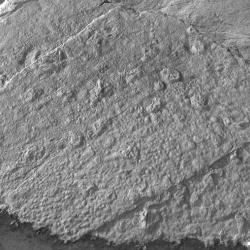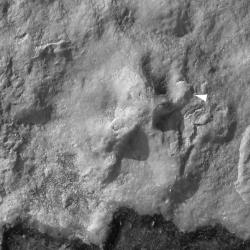Keeseville
Among the rarest of fossils: Fossil medusae (or jellyfish) are found on two sandstone bed surfaces at the Ausable River dam spillway near Keeseville, Clinton Co., N. Y. These fossils are almost unique on Earth—fossil medusae are exceptionally rare in the latest Precambrian and Phanerozoic (the interval over the last 570 million years). In addition, fossils of soft-bodied organisms are more common in fine-grained sedimentary rocks, and coarse-grained sandstones as those at the Ausable River dam rarely preserve soft-bodied organisms.
“Jellyfish conglomerates”
The two bedding surfaces at Ausable dam have over a hundred jellyfish fossils (the upper surface is marked by the yellow arrow in Figure 2, the lower surface is seen at very low water levels). The jellyfish are so abundant that they are sometimes in contact (Figure 3). Study of this outcrop shows that the jellyfish were stranded at low tide and were covered with sand. These occurrences are “conglomerates” in which the clasts were “goo-like bags” of soft living tissue.
Fossilized “goo” bags
With stranding, the jellyfish were rolled over by waning currents and distorted from the umbrella-like shape that they had as swimming, pelagic predators in the ocean. Moat-like depressions around many of the jellyfish record the final contractions of the animals as they tried to swim or crawl away. With their last contractions, sand marginal to the bell of the jellyfish was pulled under the animals. This formed the moat-like depressions and filled the underside of the bell with sand that cast the jellyfish bodies (Figure 3). A thin layer of sand likely mantled the jellyfish as the last depositional event. This sand was probably bound together by a cyanobacterial (blue green bacterial) mat as the jellyfish decayed. A stabilizing cyanobacterial mat is indicated elsewhere on the bedding surfaces by low sand domes (stromatolites), by ripples that resistanted erosion and show sharp breaches in their crests, and by desiccation cracks that formed as the sand dried out at low tide. These cracks cut into the jellyfish fossils, and suggest that the overlying sand was bound into a firm layer that fractured with drying.
Age and geologic setting:
The medusae at Ausable dam are not well preserved (i.e., there is no evidence of their tentacles or internal soft parts), but are important as they comprise one of only two known jellyfish stranding deposits in the fossil record. The Ausable dam medusae exhibit similar size ranges, morphologies, and taphonomic characteristics (or pre- and post-burial history) as those from the roughly coeval sandstones of the Elk Mound Group in Wisconsin. Both the New York and Wisconsin occurrences show anatomical features that are known from extant scyphomedusae.
The Ausable dam specimens occur in quartz sandstones of the upper Potsdam Formation (Keeseville Member). Trilobites from elsewhere in the Ausable Chasm section are early Late Cambrian in age (Figure 4).
The Potsdam Formation is one of the oldest sedimentary rock units that was laid down in New York. Sea-level rise brought Cambrian-age shorelines across much older rocks and led to deposition of the shallow-marine Potsdam sediments. The older rocks form the Adirondack Mountains dome (Figure 1) and extend underground as the basement of New York and much of eastern North America. These old rocks were formed deep underground (ca. 25 km deep) during the ca. one billion year old Grenville mountain-building interval that resulted from the collision of ancient North America with the Amazonian craton (the “core” of South America). After its formation, the Grenville Mountain belt was uplifted ca. 25 km and eroded down so that sea-level rise brought early Late Cambrian seas (ca. 495 million years ago) across eastern New York.
Paleoecologic insights:
The jellyfish and associated sedimentary rocks provide key information about the paleogeographic occurrence, size distribution, and community structure of Cambrian pelagic predators. The locality shows that large predatory jellyfish were common in Late Cambrian seas, although they are rarely preserved and would otherwise not be thought important in Cambrian ecosystems. The fact that gelatinous “goo” bags can be fossilized in a relatively high-energy sandstone facies provides insights into the exceptional preservation that can occur in Late Cambrian intertidal to supratidal settings. Their preservation probably stems from limited sediment disruption and scavenging of the buried jellyfish, as shown by the low levels of burrowing in the sandstone and abundant microbial binding.
The rocks in the spillway are dominated by planar laminated to rippled, thin-bedded, medium-grained orthoquartzites with rare mudstones, and likely represent a shallow subtidal to emergent sand-flat facies. It is only in the shallowest to emergent facies that the scyphomedusae and microbial structures are found.
Trace fossils at this site are dominated by rare horizontal forms, such as the probable mollusk trails Aulichnites and Climactichnites (“tire track-like”), the arthropod trackways Diplichnites and Protichnites (with limb impressions with three “finger-like” divisions at their end), and a burrow compared to Teichichnus (broad U-shaped burrows filled with packed sediment). A few vertically oriented trace fossils, such as Arenicolites (narrow “U-tubes”) and Skolithos (vertical tubes), are present. The best exposures of large traces are just below the spillway or on beds that are exposed only at low water. An exceptional specimen of Protichnites is displayed at the Ausable Chasm Resort entrance. This slab, collected about 100-200 m lower in the section near the Ausable Resort boathouse, is remarkable because it is not an undertrack, yet shows the delicate bifid telson impressions of the trackmaker.
NY
United States









